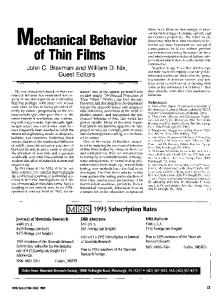Hydration behavior of MgO single crystals and thin films
- PDF / 462,527 Bytes
- 9 Pages / 612 x 792 pts (letter) Page_size
- 24 Downloads / 315 Views
Soo Gil Kim Department of Electronic Engineering, Kyungwon University, Seongnam 461-701, Korea
Sun Young Park, Mi Jung Lee, and Hyeong Joon Kima) School of Materials Science and Engineering, Seoul National University, Seoul 151-744, Korea (Received 10 June 2003; accepted 25 September 2003)
MgO single crystals and thin films were intentionally hydrated to determine the critical factors affecting the hydration behavior. The degree of hydration was affected by the crystallographic orientation in the initial stages. The (111) plane showed a higher tendency to hydrate than (100). The shape of the hydration clusters also differed according to the orientation of MgO single crystals. After long-term hydration, the density and grain size appeared to influence the hydration along with the orientation. On low-density thin films, Mg atoms are easily supplied to the surface, which induces large hydration clusters. As the grain boundary area increased, the number of nucleation sites for the formation of hydration clusters increased, which increases the number of clusters. Hydration also occurred in the inner part of thin films. The density of thin films is the most important property in this case because it governs the diffusion of Mg atoms, water, and OH through the thin films.
I. INTRODUCTION
The alternating current-plasma display panel (ACPDP) is a display device that has great potential over other display devices.1 However, AC-PDPs have serious problems. These include a short time performance, a high production cost, a high operating voltage, and high power consumption. As the AC-PDP is operated by a gas discharge phenomenon occurring around the protective layer on the dielectric layer, improvement in the overall AC-PDP characteristics, such as the operating voltage, the panel lifetime, and a reduction in the production cost, can be affected by the protective layer materials.2 The physical stability, high transmittance, and high secondary electron emission coefficient of MgO enable MgO thin films to be used as a protective layer on the dielectric layer in the AC-PDP.3,4 However, MgO has serious drawbacks, such as chemical instability: MgO physically and chemically absorbs moisture, easily forming Mg(OH)2.5,6 Water binds strongly to the MgO surface than to other oxide surfaces, partly because of the higher surface charges, but also because the lattice parameter of MgO is such that the water molecules can maximize their interaction with the surface and
a)
Address all correspondence to this author. e-mail: [email protected] J. Mater. Res., Vol. 18, No. 12, Dec 2003
http://journals.cambridge.org
Downloaded: 13 Mar 2015
hydrogen-bond to other water molecules in the monolayer.7 MgO hydration reduces the secondary electron emission coefficient of MgO film and increases the sputtering yield of the protective layer, which increases the discharge voltage and shortens the lifespan of the panel. Because all AC-PDP manufacturing processes are performed in air except for MgO deposition, subsequent treatments of a panel after
Data Loading...











